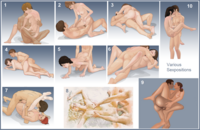
Photo from wikipedia
The understanding of reactive balance control mechanisms in humans emanates from studies utilizing a variety of perturbation methods, instructions, and sensory conditions. The use of different perturbation methods may produce… Click to show full abstract
The understanding of reactive balance control mechanisms in humans emanates from studies utilizing a variety of perturbation methods, instructions, and sensory conditions. The use of different perturbation methods may produce method-specific balance-correcting responses. This study evaluated balance-correcting responses induced with platform-translation and shoulder-pull methods with equilibrated perturbation intensities, and whether the absence of vision affects balance-correcting responses differently between perturbation methods. Fifteen healthy young males participated. Unexpected forward and backward platform-translation and shoulder-pull perturbations were induced with eyes-open and eyes-closed. Participants were asked to behave naturally. Forward stepping trials were analyzed. Margin of stability (MOS) was calculated from the position data of reflective markers placed strategically around the body. MOS was reported at step onset and at foot contact. MOS was smaller at step onset (0.01 ± 0.01 m) and at foot contact (0.09 ± 0.01 m) during platform-translation trials and at both time points during shoulder-pull trials (0.04 ± 0.01 m and 0.17 ± 0.01 m, respectively). The absence of vision did not affect MOS at step onset. At foot contact during platform-translation with eyes-closed MOS was larger (0.11 ± 0.01 m) than with eyes-open (0.08 ± 0.01 m), but not different between eyes-open (0.17 ± 0.01 m) and eyes-closed (0.18 ± 0.01 m) during shoulder-pull. Participants required a second step to recover balance in 14% of the platform-translation and 3% of the shoulder-pull trials. During platform-translation trials participants demonstrated smaller MOS which placed them in a less favorable circumstance for balance recovery. Platform-translation appears to be more challenging than shoulder-pull perturbation in terms of balance recovery. This study underscores that caution is required when interpreting results of studies utilizing different perturbation paradigms.
Journal Title: Journal of biomechanics
Year Published: 2020
Link to full text (if available)
Share on Social Media: Sign Up to like & get
recommendations!